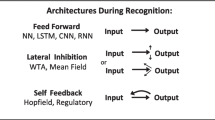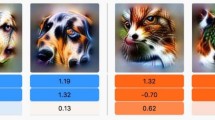Abstract
This article reviews a few key ideas about the representation of information in neural networks and uses these ideas to address one aspect of autism, namely, the apparent hyperspecificity that is often seen in autistic children's application of previously acquired information. Hyperspecificity is seen as reflecting a possible feature of the neural codes used to represent concepts in the autistic brain.
Similar content being viewed by others
REFERENCES
Ackley, D. H., Hinton, G. E., & Sejnowski, T. J. (1985). A learning algorithm for Boltzmann machines. Cognitive Science, 9, 147–169.
Cohen, I. L. (1994). An artificial neural network analogue of learning autism. Biological Psychiatry, 36, 5–20.
Gustafsson, L. (1997). Inadequate cortical feature maps: A neural circuit theory of autism. Biological Psychiatry, 42, 1138–1147.
Happé, F., & Frith, U. (1996). The neuropsychology of autism. Brain, 119, 1377–1400.
Keil, F. C. (1979). Semantic and conceptual development: An ontological perspective. Cambridge, MA: Harvard University Press.
Marr, D. (1969). A theory of cerebellar cortex. Journal of Physiology, 202, 437–470.
McClelland, J. L., McNaughton, B. L., & O'Reilly, R. C. (1995). Why there are complementary learning systems in the hippocampus and neocortex: Insights from the successes and failures of connectionist models of learning and memory. Psychological Review, 102, 419–457.
O'Reilly, R. C., & McClelland, J. L. (1994). Hippocampal conjunctive encoding, storage, and recall: Avoiding a tradeoff. Hippocampus, 4, 661–682.
Rumelhart, D. E., Hinton, G. E., & Williams, R. J. (1986). Learning internal representations by error propagation. In D. E. Rumelhart, J. L. McClelland, & the PDP Research Group (Eds.), Parallel distributed processing: Explorations in the microstructure of cognition (Vol. 1, pp. 318–362). Cambridge, MA: MIT Press.
Rumelhart, D. E., McClelland, J. L., & the PDP Research Group (1986). Parallel distributed processing: Explorations in the microstructure of cognition. Vol. I: Foundations and Vol. II: Psychological and biological models. Cambridge, MA: MIT Press.
Rumelhart, D. E., & Todd, P. M. (1993). Learning and connectionist representations. In D. E. Meyer, & S. Kornblum (Eds.). Attention and performance XIV: Synergies in experimental psychology, artificial intelligence, and cognitive neuroscience (pp. 3–30). Cambridge, MA: MIT Press.
Rumsey, J. (1992). High-functioning individuals with autism. In E. Schopler, & G. B. Mesibov (Eds.), Neuropsychological studies of high-level autism (pp. 41–64). New York: Plenum Press.
Author information
Authors and Affiliations
Rights and permissions
About this article
Cite this article
McClelland, J.L. The Basis of Hyperspecificity in Autism: A Preliminary Suggestion Based on Properties of Neural Nets. J Autism Dev Disord 30, 497–502 (2000). https://doi.org/10.1023/A:1005576229109
Issue Date:
DOI: https://doi.org/10.1023/A:1005576229109




